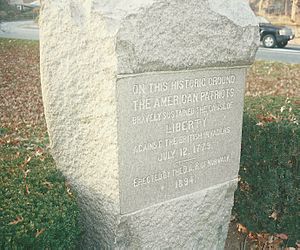Battle of Norwalk facts for kids
Quick facts for kids Battle of Norwalk |
|||||||
|---|---|---|---|---|---|---|---|
| Part of the American Revolutionary War | |||||||
 Monument commemorating the Battle of West Rocks in Norwalk, Connecticut |
|||||||
|
|||||||
| Belligerents | |||||||
| Commanders and leaders | |||||||
| Brig. General Samuel Parsons, Colonel Samuel Whiting | William Tryon, Thomas Garth | ||||||
| Strength | |||||||
| 800 | 2,500 | ||||||
| Casualties and losses | |||||||
| 20 killed, 96 wounded, 23 missing | |||||||
The Battle of Norwalk was a series of small fights during the American Revolutionary War. It is also known as the Battle of West Rocks or Battle of the Rocks. This attack was part of a larger plan by the British to raid towns along the coast of Connecticut. These raids are known as Tryon's raid. The battle took place in Norwalk, Connecticut on July 11, 1779.
Contents
What Happened in Norwalk?
British Attack on Norwalk
British forces, led by Major General William Tryon, arrived in Norwalk on July 10, 1779. They planned a two-part attack. The soldiers marched on both sides of the Norwalk River. They burned almost everything in their path. Only six houses in the main business area were saved.
American Preparations
Before the attack, Brigadier General Samuel Holden Parsons of the Continental Army was in Redding, Connecticut. Commander-in-Chief George Washington had sent him there. General Parsons was to check the situation and lead the local soldiers. Washington believed Norwalk would be the next British target. Parsons also asked Brigadier General John Glover to bring his soldiers to Norwalk.
British Landing and March
On July 10, the British ships left Huntington Bay, New York. They sailed across Long Island Sound towards Norwalk. In the evening, the ships stopped near the Norwalk Islands. Troops then began rowing to shore. One ship, the Hussar, went into the Norwalk River. Its job was to help the soldiers land and destroy any ships nearby.
The British soldiers landed at Fitch's Point. They rested there for the night. These troops included soldiers from the 54th Regiment and Hessian mercenaries. Hessian soldiers were volunteers from Germany who fought for the British. Another group of soldiers, called Loyalists, landed early the next morning.
Early Skirmishes
The British soldiers began marching towards the center of Norwalk before dawn. They faced little resistance at first. But when they reached Grumman Hill, about fifty Continental soldiers and some local militia tried to stop them. These American soldiers were led by Captain Stephen Betts. After a short fight, the British took the hill. The American soldiers had to retreat.
Fighting Along the River
Meanwhile, General Thomas Garth landed his troops in Old Well. He had two groups of Guards and two groups of fusilier soldiers. They began marching to meet Tryon's forces. At Flax Hill, they met strong resistance. Nathaniel Raymond and fourteen other local fighters from Old Well fought bravely. General Garth even lost a small cannon to these "rebels."
General Garth's troops continued along the river by West Avenue. They were constantly attacked by Norwalk militia and citizens. The British crossed the Norwalk River where Wall Street is today. The American colonists crossed upstream at Cross Street. They then moved to "the Rocks," where more militia and Betts's soldiers were waiting.
Main Battle at Mill Hill
The two British groups met near the Mill Hill area. This was by the town green. They then moved north to an area known as "the Rocks." Here, they faced heavy resistance from the Norwalk militia and Continental troops.
General Tryon started burning houses in East Norwalk. He did this because local militia were using them for cover to shoot at his soldiers. General Garth also burned buildings along West Avenue for the same reason.
Destruction and Aftermath
In total, the British burned many buildings in Norwalk. This included eighty houses, two churches, eighty-seven barns, seventeen shops, and four mills. The total damage was estimated to be over 26,000 British pounds.
General Tryon had also attacked other Connecticut towns in the days before. He attacked New Haven, Connecticut and Fairfield, Connecticut. Most of Fairfield and Norwalk were destroyed. Tryon's raids were meant to make the American forces leave the Hudson Valley. But even with pressure from Governor Trumbull, George Washington did not move his troops.
Norwalk was badly damaged. George Washington later reported to the Continental Congress that Norwalk had been "destroyed."

